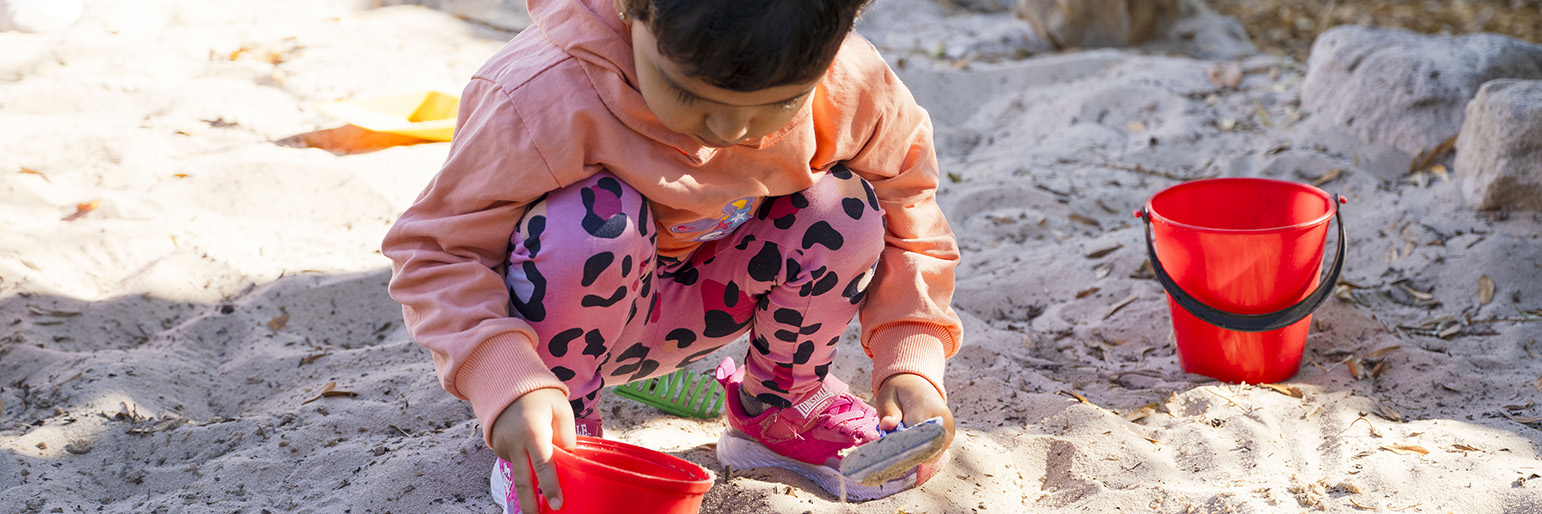Sand play
Playing together
Children learn through touching, looking, smelling, pretending, discovering and having fun.

Activity
Sand is for everyone – there is no right or wrong way to use sand, so it is appropriate for children at all stages of development.
Because of this potential, children at every age and stage of development can engage in sand play, however they would like.
Sand allows children to use their imagination, has loads of opportunity for problem-solving (‘Our castle crumbled! How might we fix that?’) and can invite social interaction between peers as well as with adults.
It can also be a calming, sensory experiences, and engage children’s attention to display persistence and model ‘staying on task’.
What you'll need
A sandpit that children can climb into is ideal, but not always possible. If you don’t have a lot of space, you can still offer sand
- in a large tub on a stand with wheels (like a water play trough)
- individual sensory trays (kitty litter trays work well)
- in a large shallow tray on a tabletop (excellent for small world play).
Buckets, shovels, rakes and spades are commonly used with sand.
Words to use
- Action words – dig, sift, scoop, fill, tip, pat, pour
- Body words – muscles, might, strong
- Sensory words – gritty, grainy, soft, dry, wet, firm, compacted, loose
- Numeracy words – half, full, more, less, next to, on top of, deep, shallow, fill up, empty
Questions to discuss
- Shall we build a sandcastle together?
- How can we fix that?
Learning through play
Ways to develop numeracy through play
- Sandpits are fabulous for developing spatial awareness... how much sand it takes to fill a bucket, how many children can fit in the sandpit comfortably, organising the castle layout, etc.
- Children can develop a sense of themselves in space, when trying to dig and perform big muscle movements without squashing their neighbours or working out how far they need to stand from the bucket when pouring in the sand with their shovel.
- Corresponding numbers when sharing equipment out with other children.
- Create layout patterns.
- Measure and comparison, when comparing one dry castle to a wet sandcastle.
Ways to develop literacy through play
- Sand play is wonderful for communication – when used socially with peers, there is problem-solving, sharing ideas and negotiating.
- Vocabulary can be extended with sand play, with both sensory words and action words.
- Manipulating sand accessories and exploring sand with fingers and hands develops eye/hand coordination. This later assists with reading and writing.
- Digging using whole body movements, moving heavy buckets, and pushing trucks and wheelbarrows builds children’s strength and core, which may assist with sitting, paying attention and listening.
Extensions and variations to this activity
For small trays:
- trucks and diggers
- water
- small world – desert animals, beach, rock pool, construction site, dinosaurs
- tea party sets
- kitchen utensils.
Sand pits (large):
- cooking or mud kitchen accessories
- trucks and diggers
- water
- pipes (plumbing offcuts and joins)
- dinosaurs with ‘volcanoes’
- animals with hills, rivers and caves.
Supporting parent engagement in play
Play prompts:
- Use words like dig, sift, scoop, fill, tip, pat, pour.
Parents or carers can:
- Comment on what their children are doing (say what you see).
- Talk in their home language.
- Use literacy and numeracy words (see words to use section above).
- Enjoy watching their child’s ideas unfold in the sandpit and stay close by for when assistance is needed.
- Support children who are unsure about the sand by gently putting their own hands in (and getting in if it’s a sandpit) and talking to them encouragingly.
- Notice what their children are doing and give them describing words – “You’re digging a deep hole in that soft sand! It looks like hard work; you’re using all your muscles!”
You can help families by:
- Modelling what you want them to do.
- Talking to them about the focus of the activity and what children might be learning.
- Writing up words that go with the activity.
- Making suggestions on what families can do at home.
Related Great Start activities
Great Start activities are for parents and carers to do with their children.


